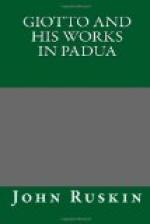Such is the account of Vasari, which, at the first reading, might be gravely called into question, seeing that the paintings at Pisa, to which he ascribes the sudden extent of Giotto’s reputation, have been proved to be the work of Francesco da Volterra;[5] and since, moreover, Vasari has even mistaken the name of the pope, and written Boniface IX. for Boniface viii. But the story itself must, I think, be true; and, rightly understood, it is singularly interesting. I say, rightly understood; for Lord Lindsay supposes the circle to have been mechanically drawn by turning the sheet of vellum under the hand, as now constantly done for the sake of speed at schools. But neither do Vasari’s words bear this construction, nor would the drawing so made have borne the slightest testimony to Giotto’s power. Vasari says distinctly, “and turning his hand” (or, as I should rather read it, “with a sweep of his hand”) not “turning the vellum;” neither would a circle produced in so mechanical a manner have borne distinct witness to any thing except the draughtsman’s mechanical ingenuity; and Giotto had too much common sense, and too much courtesy, to send the pope a drawing which did not really contain the evidence he required. Lord Lindsay has been misled also by his own careless translation of “pennello tinto di rosso” ("a brush dipped in red,”) by the word “crayon.” It is easy to draw the mechanical circle with a crayon, but by no means easy with a brush. I have not the slightest doubt that Giotto drew the circle as a painter naturally would draw it; that is to say, that he set the vellum upright on the wall or panel before him, and then steadying his arm firmly against his side, drew the circular line with one sweeping but firm revolution of his hand, holding the brush long. Such a feat as this is completely possible to a well-disciplined painter’s hand, but utterly impossible to any other; and the circle so drawn, was the most convincing proof Giotto could give of his decision of eye and perfectness of practice.
[Footnote 5: At least Lord Lindsay seems to consider the evidence collected by Foerster on this subject conclusive. Christian Art, vol. ii. p. 168.]




